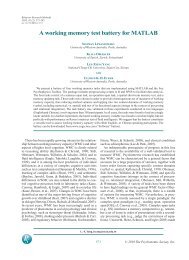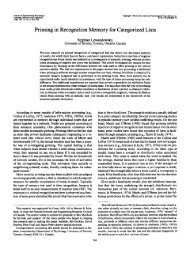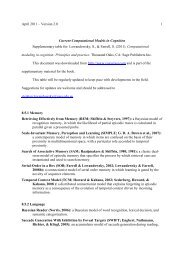Context effects in repetition priming are sense effects
Context effects in repetition priming are sense effects
Context effects in repetition priming are sense effects
Create successful ePaper yourself
Turn your PDF publications into a flip-book with our unique Google optimized e-Paper software.
624 BAINBRIDGE, LEWANDOWSKY, AND KIRSNER<br />
Table 3<br />
Response Latencies for Correct Lexical Decisions (<strong>in</strong> Milliseconds)<br />
<strong>in</strong> Block 2 <strong>in</strong> Experiment 3<br />
Number of Senses of Target<br />
Condition Many Error Rates S<strong>in</strong>gle Error Rates<br />
Same context 648 .02 699 .03<br />
Different context 713 .04 693 .04<br />
Control 732 .02 767 .07<br />
and few-<strong>sense</strong> items <strong>in</strong> Experiments 1 and 2, the next<br />
study was designed to reduce the demand characteristics<br />
that might engender the formation of explicit associations<br />
between context and target. Thus, the subjects <strong>in</strong> Experiment<br />
3 were required to read the context sentences aloud<br />
without mak<strong>in</strong>g a decision about their grammaticality.<br />
Method<br />
Forty-n<strong>in</strong>e University of Oklahoma undergraduates participated<br />
for course credit. The subjects <strong>in</strong> this experiment were required<br />
to read context sentences aloud but were not required to make a<br />
grammaticality decision. Therefore, we no longer used filler items<br />
with ungrammatical context sentences. Otherwise, the stimuli and<br />
procedures were identical to those used <strong>in</strong> Experiment 2.<br />
Results and Discussion<br />
Reaction times and error rates <strong>are</strong> shown <strong>in</strong> Table 3.<br />
An analysis of the error rates showed an effect of <strong>sense</strong><br />
[F(1 ,48) = 5.96, MSe = 0.0074] but no effect of condition,<br />
and no <strong>in</strong>teraction between the two [F(2,96) = 1.27,<br />
MSe = 0.0068, and F(2,96) = 2.40, MSe = 0.0048,<br />
respectively].<br />
Analyses of reaction times showed an effect of both<br />
<strong>sense</strong> and condition [F(2,48) = 3.35, MSe = 10,771, and<br />
F(2,96) = 21.10, MSe = 6,769, respectively], and an<br />
<strong>in</strong>teraction between the two [F(2,96) = 3.82, MSe =<br />
8,818]. Subsequent analysis of the <strong>in</strong>teraction us<strong>in</strong>g the<br />
LSD of 38 msec showed that <strong>repetition</strong> prim<strong>in</strong>g was elim<strong>in</strong>ated<br />
when context was changed for the many-<strong>sense</strong> items<br />
but that <strong>repetition</strong> prim<strong>in</strong>g was ma<strong>in</strong>ta<strong>in</strong>ed across a change<br />
<strong>in</strong> context for the s<strong>in</strong>gle-<strong>sense</strong> items. The results confirm<br />
that the outcome of Experiments 1 and 2 was probably<br />
not caused by an explicit “backward” association between<br />
the context sentence and the target.<br />
GENERAL DISCUSSION<br />
Summary<br />
We reported three experiments that clarified the role<br />
of context <strong>in</strong> <strong>repetition</strong> prim<strong>in</strong>g of lexical decisions. The<br />
results of all threeexperiments support the <strong>in</strong>terpretation<br />
that prim<strong>in</strong>g depends not only on <strong>repetition</strong> of the same<br />
physical word form but also on the <strong>repetition</strong> of the same<br />
context-selected <strong>sense</strong>. When <strong>sense</strong> was changed, prim<strong>in</strong>g<br />
was elim<strong>in</strong>ated, whereas a context change that did not<br />
also change perceived <strong>sense</strong> was <strong>in</strong>consequential. The data<br />
from these experiments support previous f<strong>in</strong>d<strong>in</strong>gs (Lewandowsky<br />
et al., 1989; Masson & Freedman, 1990) that<br />
demonstratedthe importance of encoded mean<strong>in</strong>g <strong>in</strong> <strong>repetition</strong><br />
prim<strong>in</strong>g and, therefore, implicit memory. Thus, any<br />
view of implicit memory must acknowledge the role of<br />
context and context-selection of mean<strong>in</strong>g.<br />
Sense-Specific Activation<br />
As stated at the outset, our work<strong>in</strong>g assumption was<br />
that the number of <strong>sense</strong>s of a word is reflected <strong>in</strong> the<br />
number of its <strong>in</strong>ternal representations and that prim<strong>in</strong>g<br />
occurs if the same representation is reactivated at a later<br />
po<strong>in</strong>t. This <strong>sense</strong>-specific activation mechanism not only<br />
expla<strong>in</strong>s the outcome of our experiments but also sheds<br />
light on some diverse previous results.<br />
Presentation <strong>in</strong> context. In our view, each timea word<br />
is encountered, its mean<strong>in</strong>g is determ<strong>in</strong>ed by its context,<br />
and the representation correspond<strong>in</strong>g to that <strong>sense</strong> is activated.<br />
This specific and narrow <strong>in</strong>terpretation given to<br />
a word is evident on later implicit tests of memory: If a<br />
different context is present, and there is a large number<br />
of alternative representations for a word (dom<strong>in</strong>ant mean<strong>in</strong>g<br />
of homographs or polysemouswords), <strong>repetition</strong> prim<strong>in</strong>g<br />
is likely to be absent. If there <strong>are</strong> fewer representations<br />
(subord<strong>in</strong>ate mean<strong>in</strong>g, or words with few <strong>sense</strong>s),<br />
prim<strong>in</strong>g may persist <strong>in</strong> a different context—unless perceived<br />
<strong>sense</strong> is also changed—because the probability of<br />
access<strong>in</strong>g the same representation aga<strong>in</strong> is higher.<br />
<strong>Context</strong>-free presentation. Words <strong>are</strong> often encountered,<br />
and understood, without any recourse to a specific<br />
context. In these situations, words have a preferred customary<br />
mean<strong>in</strong>g (Allan, 1981). For example, the customary<br />
mean<strong>in</strong>g of LAMB would refer to the meat, and<br />
only when context is present would it also refer to the<br />
pelt, the head, or still other nuances. Because the customary<br />
mean<strong>in</strong>g will, on average, be activated each time<br />
a word is presented <strong>in</strong> isolation, <strong>repetition</strong> of isolated<br />
words facilitates process<strong>in</strong>g.<br />
Now consider the <strong>effects</strong> of remov<strong>in</strong>g context between<br />
study and text. When study words <strong>are</strong> part of cont<strong>in</strong>uous<br />
text and <strong>are</strong> later presented <strong>in</strong> isolation for perceptual identification<br />
(see, e.g., Levy & Kirsner, 1989), lexical decisions<br />
(see, e.g., Oliphant, 1983), or fragment completion<br />
(MacLeod, 1989), <strong>repetition</strong> prim<strong>in</strong>g is absent or,<br />
at best, m<strong>in</strong>imal. In our view, a specific, context-selected<br />
mean<strong>in</strong>g was encoded at study, whereas the isolated presentation<br />
at test favored encod<strong>in</strong>g of the less specific customary<br />
mean<strong>in</strong>g. Because these two mean<strong>in</strong>gs frequently<br />
do not overlap, little or no prim<strong>in</strong>g is observed. Interest<strong>in</strong>gly,<br />
<strong>in</strong> MacLeod’s study, considerably more prim<strong>in</strong>g<br />
accrued to words that, although also “part” of the study<br />
text, were not constra<strong>in</strong>ed by context. The subjects had<br />
to identify and cross out words that did not fit mean<strong>in</strong>gfully<br />
<strong>in</strong>to a passage of text, and these words, unbound<br />
by surround<strong>in</strong>g context, were primed more than were<br />
words that were mean<strong>in</strong>gfully <strong>in</strong>tegrated <strong>in</strong>to the passage.<br />
In our view, the lack of <strong>in</strong>tegrative context permitted<br />
selection of the customary <strong>sense</strong> on both occasions, thus<br />
lead<strong>in</strong>g to <strong>repetition</strong> prim<strong>in</strong>g <strong>in</strong> the same way that s<strong>in</strong>gle<br />
items <strong>are</strong> facilitated across blocks.





